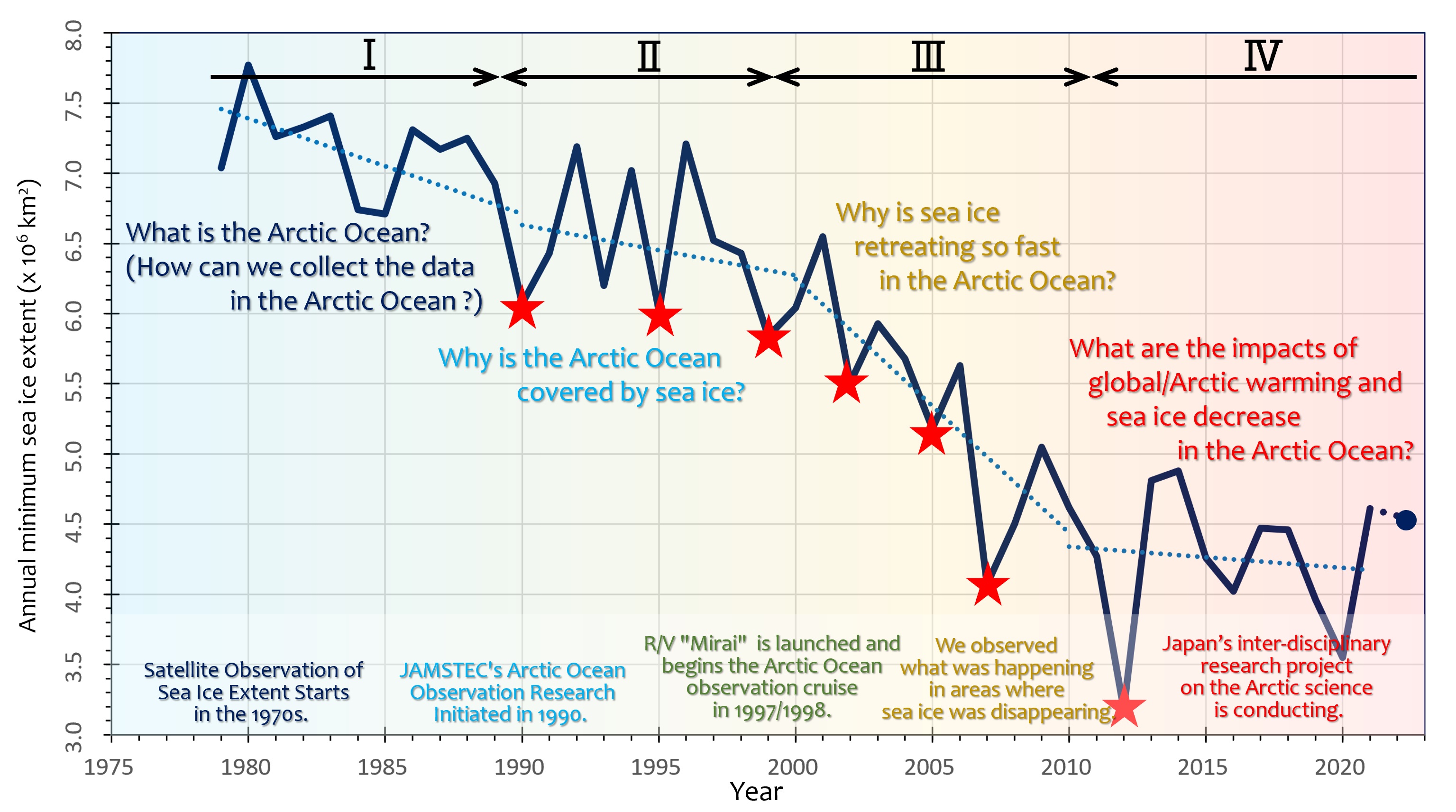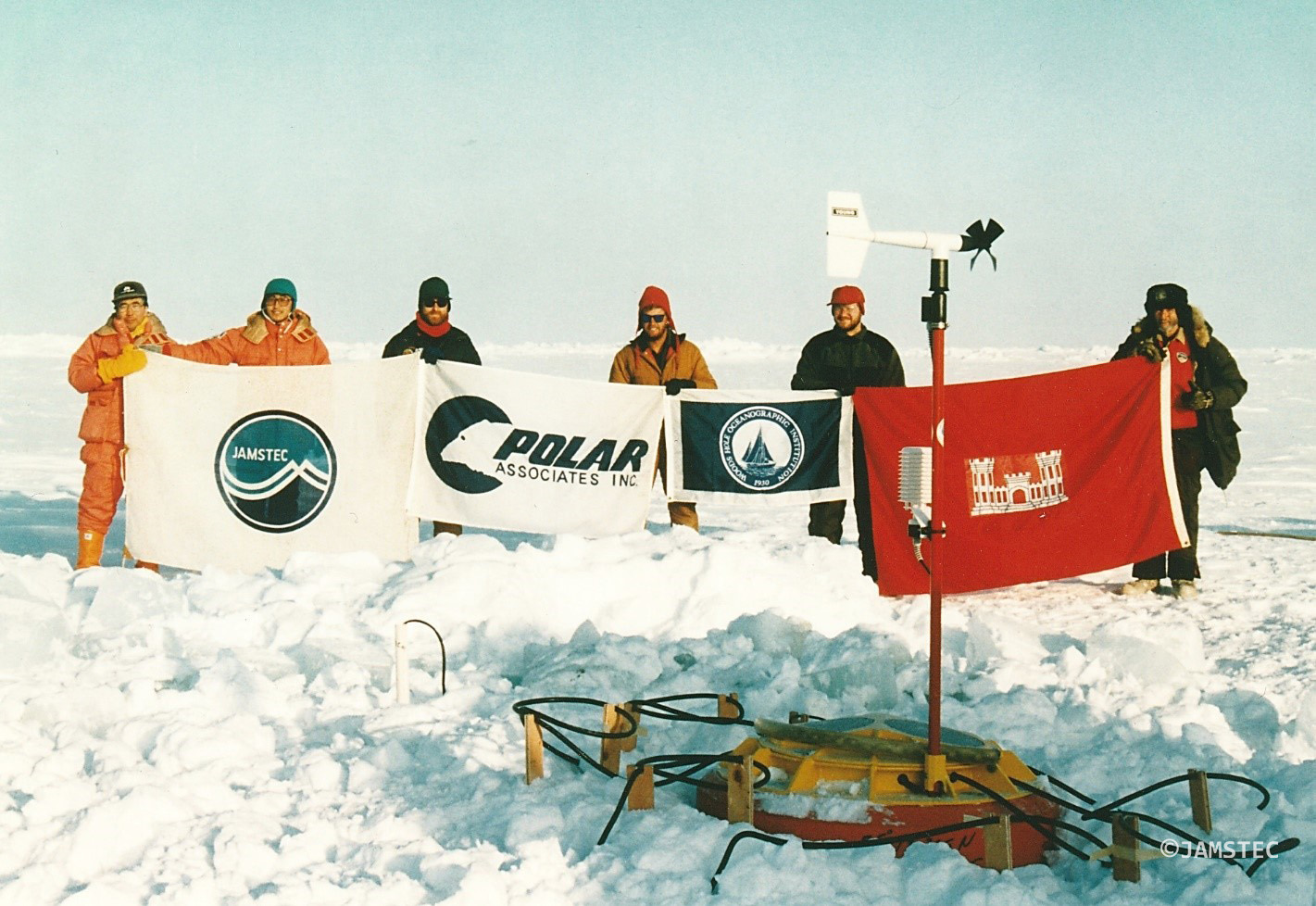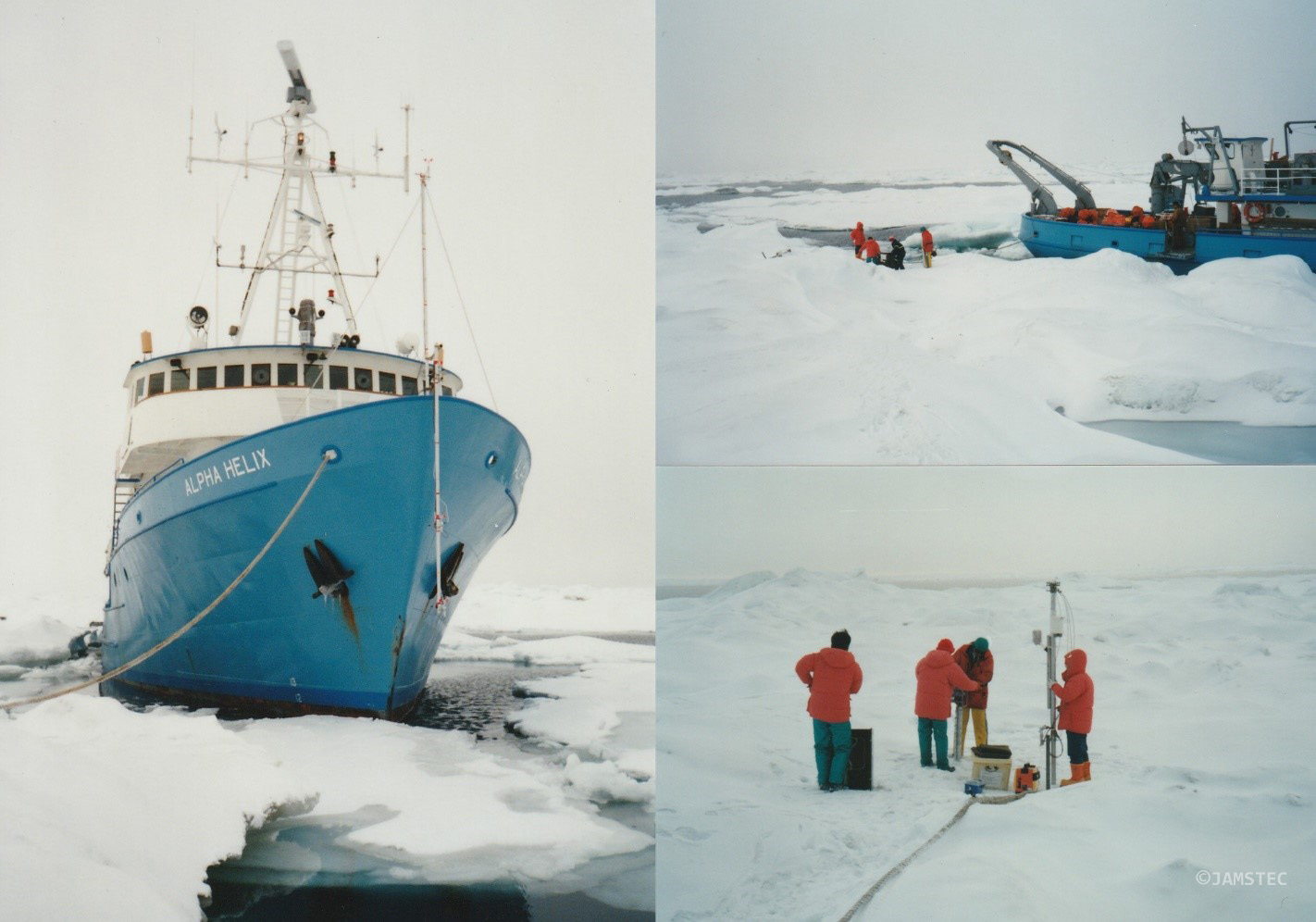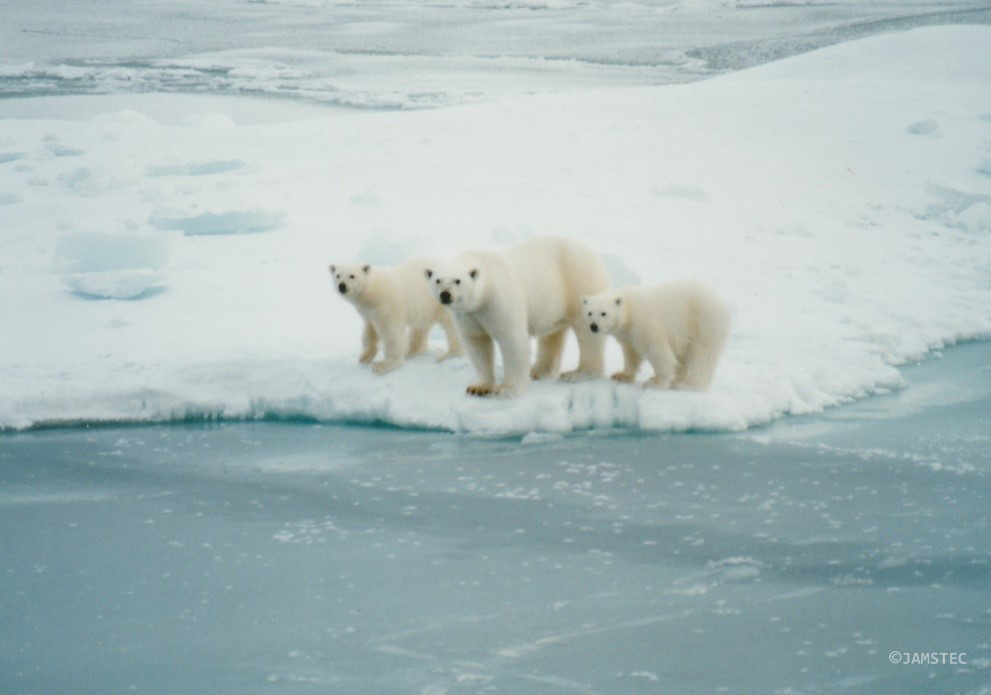Observational Research in the Arctic Ocean to date - Chapter II: Launching
October 6, 2022
Takashi KIKUCHI,
Director, Inst. Arctic Climate and Environment Res., Research Inst.
Global Change/Group Leader,
International Observation Planning Group,
Project Office for Arctic Research Vessel (PARV)
This article describes the history of Arctic Ocean observation and research to date, focusing mainly on the activities of Japan and JAMSTEC. Figure 1 shows the interannual variation of minimum sea ice extent in the Arctic Ocean revealed by satellite observation since 1979 with some comments about the purposes and activities of the Arctic Ocean observation. We divide the period from the start of satellite-based sea ice observations in the 1970s to the present into four periods and summarize the objectives and research activities conducted during each period.

II: Launching
As shown in the previous chapter, we were able to use satellite data to know the distribution of sea ice in the Arctic Ocean in the late 1980s. Using these sea ice distribution data, researchers attempted to develop in-situ observations. Then, icebreakers, which were used for Antarctic observation and base maintenance, began to go for the Arctic Ocean observations. For example, the German icebreaker Polarstern conducted hydrographic observation across the Nansen Basin in the Atlantic sector of the Arctic Ocean in 1987. This was the first trans-Arctic Ocean basin observation by one of the western countries.
While momentum for Arctic Ocean research was growing described above, a major change occurred in the international community in the late 1980s and early 1990s. This was the end of the Cold War. In the Murmansk Initiative of 1987, Mikhail Gorbachev, then General Secretary of the Communist Party of the Soviet Union, proposed the "opening of the Arctic. In this proposal, the importance of scientific research in the Arctic was pointed out, and the importance of international scientific cooperation was also emphasized. This led to international discussions on Arctic research.
For example, the Rovaniemi Declaration was adopted in June 1991 for environmental protection. This declaration led to the establishment of four working groups (AMAP, PAME, CAFF, EPPR*) that have been active under the Arctic Council. In 1990, the International Arctic Science Committee (IASC), a non-governmental organization led by researchers, was established. Initially established as an organization of eight Arctic nations (Canada, Denmark, Finland, Iceland, Norway, Russia, Sweden, and the United States), at the first IASC Council meeting, research institutions from France, Germany, Japan, the Netherlands, Poland, and the United Kingdom also became official members. The IASC now has 23 member countries and plays a very important role in promoting international collaboration in Arctic research.
With the growth of such international research collaborations on the Arctic, Japan also began to promote Arctic research in an organized manner. For example, the National Institute of Polar Research (NIPR) established the Arctic Environment Research Center. Then, Ny-Ålesund NIPR Observatory was established in Ny-Ålesund, Spitsbergen, Svalbard, Norway, in 1991. The observatory continues to serve as a useful base for observations such as atmospheric chemistry, terrestrial ecosystems, and so on.
JAMSTEC began research and development(R&D)of the Arctic Ocean observation in collaboration with the Woods Hole Oceanographic Institution (WHOI) and the University of Alaska (UAF). In the early 1990s, the sea ice conditions in the Arctic Ocean had not changed much from the 1980s. Most areas of the Arctic Ocean were covered with sea ice even in summer. Because of fewer experiences of the Arctic Ocean observation, we were "grasping for clues" as to how to observe the Arctic Ocean covered with sea ice and what kind of observation data we could obtain. Our first objective of R&D was “to observe and collect data," so to speak, “to know the Arctic Ocean”.
In collaboration with WHOI, we jointly developed the "Ice Ocean Environmental Buoy (IOEB)," which was set up on sea ice to collect data and samples under the sea ice as it drifted, and conducted atmospheric, sea ice, and upper ocean observation in the multi-year ice area of the Arctic Ocean between 1991 and 2001. Technical details were written in Hatakeyama et al. (1996, written in Japanese) and the IOEB program website in WHOI. The operation of IOEB in the multi-year ice area is as follows. We moved on the multi-year sea ice (target area) by helicopter or small aircraft, drilled a hole in the sea ice, set up the IOEB, and started drifting observation sending basic buoy and observation data via satellite. After a few years, taking into account the remaining battery capacity, we went to the IOEB location as drifting, retrieved it, and were able to collect the data and samples. The data obtained from the IOEB was not only used for research but was also distributed to Global Telecommunication System (GTS) in real-time under the International Arctic Buoy Programme (IABP) activities and used for weather forecasting and other current business activities. Figure 2 shows a photo of the installation of IOEB-2 in April 1994. Under this WHOI-JAMSTEC collaboration, we enabled to obtain observation experiences and meteorological, sea ice, and oceanographic data in the multi-year sea ice area of the Arctic Ocean.

In collaboration with the University of Alaska, Fairbanks (UAF), using the oceanographic vessel Alpha Helix, we conducted hydrographic observations, mooring deployment & recovery operations, meteorological observations, and sea ice observations off the Alaskan coast area of the Arctic Ocean (Figures 3 and 4). Mainly during the summer months when the sea ice edge retreated, we have accumulated experience in oceanographic and sea ice observations using the Alpha Helix. In contrast, to obtain data throughout the year, including the ice-covered winter months, we learned how to use mooring systems in seasonally ice-covered waters. And then, we accumulated knowledge on the unique condition of the Arctic Ocean, which allows the existence of sea ice.


These experiences in the 1990s led to the development of the JAMSTEC Compact Arctic Drifter (J-CAD) and observation research using JAMSTEC research vessel “Mirai” in the Pacific sector of the Arctic Ocean, which will be conducted in the late 1990s and 2000s. This will be described in the next column. In summary, during this period, we will accumulate observation experience and data in the Arctic Ocean in collaboration with WHOI and UAF. In the process, we not only obtained data, which was our initial purpose but also were able to start observational “research” activities to answer scientific questions such as "Why does sea ice exist in the Arctic Ocean?”.
Acknowledgments:
We would like to thank Dr. T. Takizawa, Mr. K. Hatakeyama, and Dr. T. Nakamura, who were members of the Arctic Ocean R&D group of JAMSTEC at that period, for their cooperation in compiling this chapter.
References
i. Rachold, V. (2022). “Success Stories of International Cooperation in the Arctic”, Article on the web site of “Arctic Circle”, 8 July 2022. https://www.arcticcircle.org/journal/success-stories-of-international-cooperation-in-the-arctic
ii. International Arctic Science Committee (IASC) Home page https://iasc.info/ (Referred on 2022-8-30)
iii. Hatakeyama, K., T. Takizawa, T. Nakamura, S. Honjo, R. Krishfield, and N. Koyama (1996). Development of Ice-Ocean Environmental Buoy (IOEB), JAMSTEC-R, 34, 1-15. (In Japanese)
iv. Ice-Ocean Environmental Buoy (IOEB) Program Home Page https://www2.whoi.edu/site/ioeb/ (Referred on 2022-10-05)
v. Takizawa, T. (2001). Observational Research in the Arctic Ocean. The 30th Anniversary of the Japan Marine Science and Technology Center, Chapter 2. As a comprehensive marine research institute, p.102-108. (In Japanese)
vi. Kikuchi, T. (2022). History and Future of Arctic Ocean Research-Toward New Japanese Research icebreaker for the Arctic Ocean-. KANRIN/Bulletin of The Japan Society of Naval Architects and Ocean Engineers, 101, 28-34. (In Japanese)
*Abbr.
AMAP: Arctic Monitoring and Assessment Programme
PAME: Protection of the Arctic Marine Environment
CAFF: Conservation of Arctic Flora and Fauna
EPPR: Emergency Prevention, Preparedness and Response

